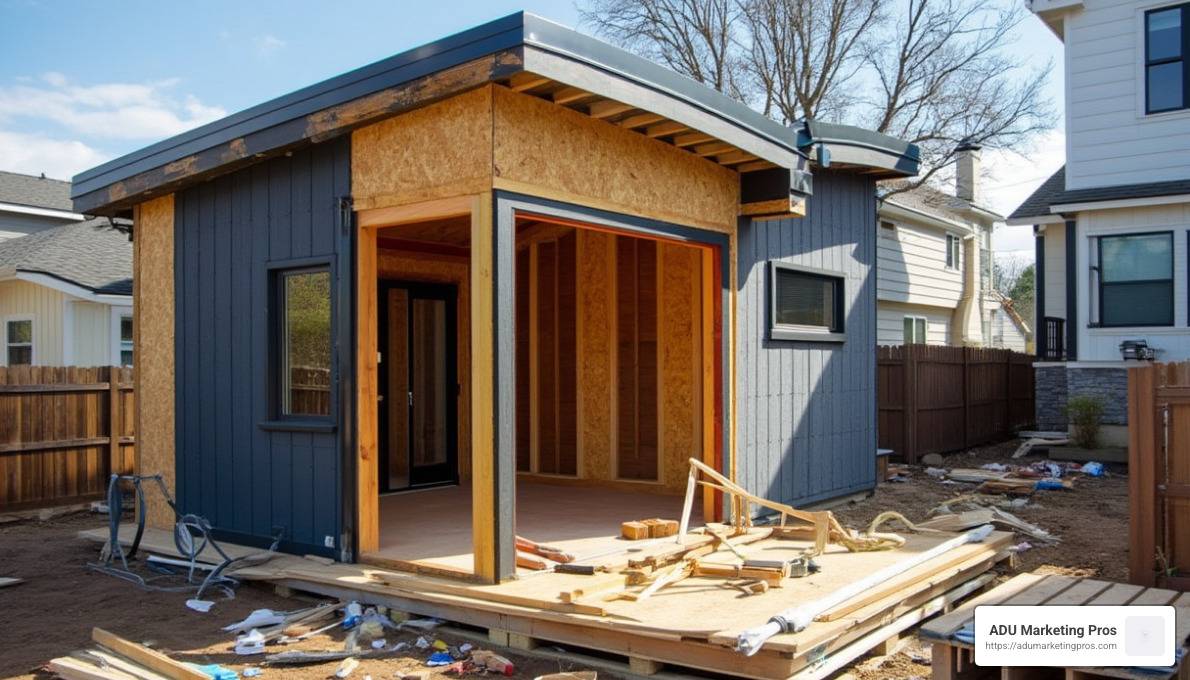ADU financing options have become a hot topic as Accessory Dwelling Units (ADUs) continue to gain traction across the United States, particularly in busy urban centers like California. If you’re looking to dive into ADU investments, understanding your financing options is crucial. Here’s a quick rundown to get you started:
- Home Equity Line of Credit (HELOC)
- Home Equity Loan
- Cash-Out Refinance
- Construction Loan
- RenoFi Renovation Loan
Contemporary housing trends are increasingly pivoting towards smaller, more efficient living spaces. ADUs, often affectionately referred to as granny flats or in-law suites, are popping up in backyards and attics as more homeowners pursue flexible living arrangements amid ongoing housing pressures.
California, a pioneer in ADU adoption, has recently implemented several legislative changes to facilitate their construction. These regulatory adaptations aim to address housing shortages while providing homeowners with innovative ways to increase property value and create rental income streams.
However, financing challenges remain a significant hurdle for many aspiring ADU builders. The multitude of available options—ranging from tapping into home equity to specialized renovation loans—can be overwhelming. Navigating these choices requires a keen understanding of personal financial circumstances and future property valuation.
Starting on the ADU journey demands careful consideration of not only the potential benefits but also the financial complexities involved. This guide aims to explain ADU financing, empowering you to make informed decisions that align with your goals and optimize your investment.

ADU financing options vocabulary:
– adu loan rates
– construction loans for adu
Understanding ADU Financing Options
When it comes to financing your Accessory Dwelling Unit (ADU), there are several ADU financing options available. Each option comes with its own set of benefits and considerations. Let’s break down the key options:
Home Equity Line of Credit (HELOC)
A HELOC is like a credit card backed by the equity in your home. It provides a revolving line of credit, allowing you to withdraw funds as needed during a draw period. This flexibility is great for managing ongoing construction costs, making it a popular choice for ADU projects.
- Variable Interest Rates: Be mindful that rates can fluctuate.
- Draw and Repayment Periods: Typically, there’s a 10-year draw period followed by a repayment period.
Home Equity Loan
A home equity loan is a second mortgage that gives you a lump sum upfront. It’s perfect if you have a clear budget and want stable, predictable payments.
- Fixed Interest Rate: This offers budgeting stability.
- Lump Sum: You receive all funds at once, which is great for projects with a defined cost.
Cash-Out Refinance
This option involves refinancing your existing mortgage to pull out equity as cash. It’s useful if you’re looking to consolidate your mortgage and ADU financing into one.
- Primary Mortgage Refinance: This replaces your existing mortgage.
- Fixed Interest Rate: Provides consistency in monthly payments.
Construction Loan
Construction loans are designed specifically for building projects, including ADUs. They cover costs during construction, which later convert into a regular mortgage upon completion.
- Short-Term Financing: Typically lasts until the project is complete.
- Interest-Only Payments: During construction, you only pay interest on the amount drawn.
RenoFi Renovation Loan
The RenoFi loan is custom for renovations and considers the future value of your home post-ADU construction. It allows you to borrow more by factoring in your property’s increased value.
- Future Home Value: Increases borrowing power.
- Fixed Rate: Offers peace of mind with predictable payments.

Navigating these ADU financing options requires understanding your financial situation, credit score, and long-term property goals. Each option provides unique benefits, so it’s crucial to align your choice with your specific needs and circumstances.
Next, we’ll explore the key factors influencing ADU loan rates, helping you make the most of your investment.
Key Factors Influencing ADU Loan Rates
Understanding the factors that impact your ADU loan interest rates is crucial for making informed decisions. Here’s a breakdown of the primary elements:
Credit Score
Your credit score is a significant factor in determining your interest rate. Lenders use it to evaluate your reliability as a borrower. A higher score typically means lower interest rates.
- Good Score: Aim for a score of 670 or higher for better rates.
- Improvement Tips: Check for errors on your report, pay bills on time, and consider a secured credit card to build credit if needed.
Loan Term & Type
The structure of your loan also affects your interest rates.
- Fixed-Rate Loans: These offer stability, as your rate won’t change over time.
- Variable-Rate Loans: Rates can fluctuate based on market conditions, potentially increasing your costs.
Market Conditions
Economic factors play a role in the interest rates you receive.
- Inflation: In times of inflation, rates may increase.
- Recession: During economic downturns, rates might be lower to stimulate borrowing.

Lender Policies
Every lender has unique policies and risk assessments that influence the rates they offer.
- Shop Around: Compare different lenders to find the best rates and terms.
- Policy Variations: Some lenders may offer better rates based on their specific criteria and risk assessments.
By understanding these factors, you can better steer your ADU financing options and secure the most favorable loan terms. Next, we’ll look at the steps to secure an ADU loan, ensuring you’re well-prepared for the application process.
ADU Financing Options: A Detailed Guide
When it comes to ADU financing options, understanding the details of each can help you make the best decision for your project. Let’s explore the main types of loans available:
Home Equity Line of Credit (HELOC)
A HELOC is like a credit card for your home equity. It offers a variable interest rate, which means your payments can go up or down over time. Here’s how it works:
- Draw Period: You can borrow money as needed, typically for 5-10 years. During this time, you only pay interest on what you borrow.
- Repayment Period: After the draw period, you start paying back both the principal and interest, usually over 10-25 years.
HELOCs are flexible but come with the risk of rising interest rates.
Home Equity Loan
A Home Equity Loan is a fixed-rate option, often called a second mortgage. It provides a lump sum of cash upfront, which you repay over a set period.
- Second Mortgage: You keep your primary mortgage and add this loan on top.
- Upfront Lump Sum: Get all the money at once, which helps with budgeting.
This option is great for those who want stable payments and have significant home equity.
Cash-Out Refinance
With a Cash-Out Refinance, you replace your existing mortgage with a new one, taking out extra cash based on your home’s equity.
- Primary Mortgage: This becomes your main mortgage, consolidating your debt.
- Equity Release: You access your home’s equity to fund the ADU construction.
- Fixed Interest Rate: Locks in your rate, providing predictability.
This is ideal for homeowners with substantial equity who want to manage one mortgage.
Construction Loan
A Construction Loan is designed specifically for building projects. It offers short-term financing with unique features.
- Short-Term: Covers the construction period, typically 6-12 months.
- Interest-Only Payments: Pay only interest during construction, keeping costs low initially.
- Conversion to Mortgage: Once construction is complete, it converts to a regular mortgage.
It’s a smart choice for those focused on construction, but it requires a clear plan for conversion.
RenoFi Renovation Loan
RenoFi Loans are innovative, considering the future home value after your ADU is complete. This boosts your borrowing power significantly.
- Future Home Value: Borrow based on what your home will be worth post-renovation.
- Borrowing Power: Often increases borrowing by 3x or more compared to traditional options.
- Fixed Rate: Offers stability and peace of mind.
RenoFi Loans are excellent for homeowners with limited current equity but strong future value potential.
By understanding these ADU financing options, you can choose the one that aligns best with your financial situation and project goals. Up next, we’ll cover the steps to secure an ADU loan, ensuring you’re well-prepared for the application process.
Steps to Secure an ADU Loan
Securing an ADU loan involves several key steps, each essential to ensuring you get the best financing for your project. Let’s break down the process:
1. Determine Your Loan Amount
Start by figuring out how much you’ll need to borrow. This involves:
- Budget Planning: Discuss your financial goals with a financial advisor to set a realistic budget.
- Contractor Estimates: Obtain 3-4 estimates from local contractors based on your ADU plans. This helps gauge the total cost and informs your loan amount.
Understanding your financial limits and project costs is crucial before moving forward.
2. Assess Your Eligibility
Next, check your eligibility for the loan:
- Use Mortgage Calculators: Tools like the RenoFi Loan Calculator can provide an estimate of what you might qualify for. Input details like your Debt-to-Income (DTI) ratio, FICO score, and income.
- Pre-Qualification: Consider using pre-qualification tools to see if specific loans, like a RenoFi loan, are suitable for you.
These steps help you understand how much you can potentially borrow.
3. Research Lenders
Finding the right lender is key to securing favorable terms:
- Get Referrals: Ask friends and family for recommendations on reputable lenders.
- Compare Offers: Look into different lenders to compare loan types, interest rates, and any available discounts.
- Credit Union Networks: Consider networks like RenoFi’s, which can connect you to credit unions offering competitive rates.
Thorough research can lead to significant savings on your loan.
4. Gather Your Documentation
Having the right documentation ready can streamline your application process:
- Income Proof: Collect your two most recent pay stubs and two years of W-2 forms.
- Financial Statements: Include recent bank, retirement, and investment account statements.
- Property Information: Provide proof of homeowner’s insurance and your most recent mortgage statement.
- Project Details: Prepare contractor information, a detailed cost estimate, and renovation plans (blueprints, contracts).
Organized documentation speeds up the approval process.
By following these steps, you can confidently steer the loan application process and secure the funding needed for your ADU project. Next, we’ll address some frequently asked questions about ADU financing options to further guide you.
Frequently Asked Questions about ADU Financing Options
What is the best loan to build an ADU?
When it comes to building an ADU, the RenoFi Renovation Loan often stands out as a top choice. This loan is unique because it considers the future value of your home after the ADU is built. This means you can borrow more money than with traditional loans, even if you haven’t built up significant equity yet. The fixed interest rate provides stability, so you know what your payments will be each month. This loan is designed to boost your borrowing power, making it easier to cover construction costs.
Can I use potential rental income to qualify for a higher loan amount?
Yes, you can! Some lenders allow you to use the anticipated rental income from your ADU to qualify for a larger loan. This is particularly true for DSCR (Debt Service Coverage Ratio) loans. Unlike traditional loans that rely heavily on your personal income, DSCR loans focus on the property’s cash flow. If your ADU is expected to generate rental income, it could help you qualify for a higher loan amount, making it a smart choice for those looking to maximize their borrowing potential.
What are the interest rates for ADU loans?
Interest rates for ADU loans can vary based on several factors:
- Credit Score: A higher credit score usually means lower interest rates.
- Loan Term & Type: Fixed-rate loans offer consistent payments, while adjustable rates can fluctuate.
- Market Conditions: Economic factors, such as inflation or housing demand, can impact rates. For instance, lower demand often results in higher rates.
- Lender Policies: Different lenders have varying rate structures based on their policies and risk assessments.
Always shop around and compare rates from different lenders to ensure you get the best deal based on current market conditions. Monitoring these trends will help you make informed decisions when financing your ADU.
Next, we’ll explore the conclusion, focusing on how ADU Marketing Pros can offer expert guidance and custom solutions for your ADU financing needs.
Conclusion
Navigating ADU financing options can feel overwhelming, but you don’t have to go it alone. At ADU Marketing Pros, we specialize in helping ADU construction and architecture firms stand out in a competitive market. Our expertise in digital marketing solutions ensures that your firm attracts high-quality leads and grows its revenue.
Expert Guidance
Our team understands the unique challenges faced by ADU businesses. We provide custom strategies to help you steer the complexities of financing and construction. With our continuous market research and data-driven insights, we adapt our services to evolving regulations and consumer behaviors, ensuring you’re always a step ahead.
Custom Solutions
Whether you’re looking to attract clients ready to invest in premium ADU projects or need help with targeted SEO, PPC, and social media strategies, we have you covered. Our approach is all about delivering measurable growth for your firm while building a strong, recognizable brand identity.
If you’re ready to explore how we can help your ADU business thrive, check out our ADU Marketing Solutions for more information on how we can support your journey.
Let us be your trusted partner in turning complex financing challenges into opportunities for growth and success.




